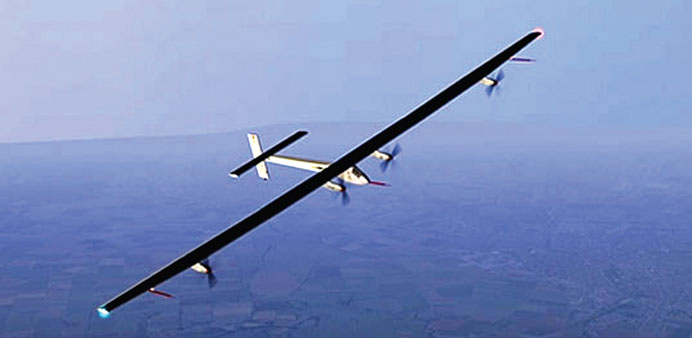The Swiss embassy is hosting an exhibition about Solar Impulse, the first aircraft to fly around the world completely powered by solar energy, and clean-technology originating from Switzerland, from today until next
Wednesday at City Center Doha.
Swiss ambassador Martin Aeschbacher and City Center Doha director Joerg Harengerd, will be present at the opening
at 11am.
Swiss explorers Bertrand Piccard and André Borschberg are the founders, pilots and driving force behind Solar Impulse, the first airplane of perpetual endurance, able to fly day and night without a drop of fuel.
By attempting the first Round the World Solar Flight, they want to demonstrate that clean technologies and renewable energies can achieve the impossible. The Round-The-World flight started
from Abu Dhabi, on March 9.
The route includes stopovers in Oman, India, Myanmar and China, where it landed in Nanjing on April 21. There are no flights before May 11. After trying to cross the Pacific Ocean via Hawaii, the aircraft should fly across the US and over the Atlantic Ocean, heading back to Abu Dhabi.
In all, the plane is scheduled to land in 12 locations across the planet. Upon completion of the journey, it will have travelled 35,000km on solar energy. The aircraft has a wingspan of 72m (larger than a Boeing 747) and 17,248 solar cells built into to wing to supply four electric motors (17.5 hp each). Solar Impulse just weighs 2,300 kg, equivalent to the weight of a car.
The idea was born sixteen years ago in Switzerland in 1999, when Piccard flew around the world with a hot air balloon in a non-stop-journey. By initiating the Solar Impulse project and aiming to fly round the world in a solar airplane, he is seeking to promote technologies that help conserve Earth’s natural resources. Psychiatrist, aeronaut and lecturer, chairman of the Winds of Hope humanitarian foundation and goodwill ambassador for the United Nations, Piccard is passionate about today’s great
human challenges.
Piccard hails from a family of adventurers. His grandfather Auguste Piccard flew on August 18, 1932, with a balloon to the stratosphere and to an altitude of 16,940m above sea level.
Piccard’s father Jacques dived on January 23, 1960, to the deepest spot below sea level, the Marian Trench at 10,916m.
Piccard shares with Borschberg control of this project, just as he shares with him the controls of the aircraft. Being an engineer by education and a graduate of the Massachusetts Institute of Technology in management science and as a former jet-fighter pilot in the Swiss Airforce, Borschberg directs the construction of the aircraft and the preparation of the flight missions.
The Ecole Polytechnique Fédérale de Lausanne in Switzerland brings to the project its scientific and intellectual skills in more than ten areas of research. It is particularly keen to meet challenges in the fields of ultra-light structures, energy chain management, and man-machine interfaces.
The expertise of the European Space Agency has proved invaluable in several areas of technology: batteries and solar cells, energy management systems and ultra-light
construction materials.
Visitors to the exhibition at City Center Doha can participate in a competition and win many prizes, the Swiss embassy has added.

Solar Impulse


